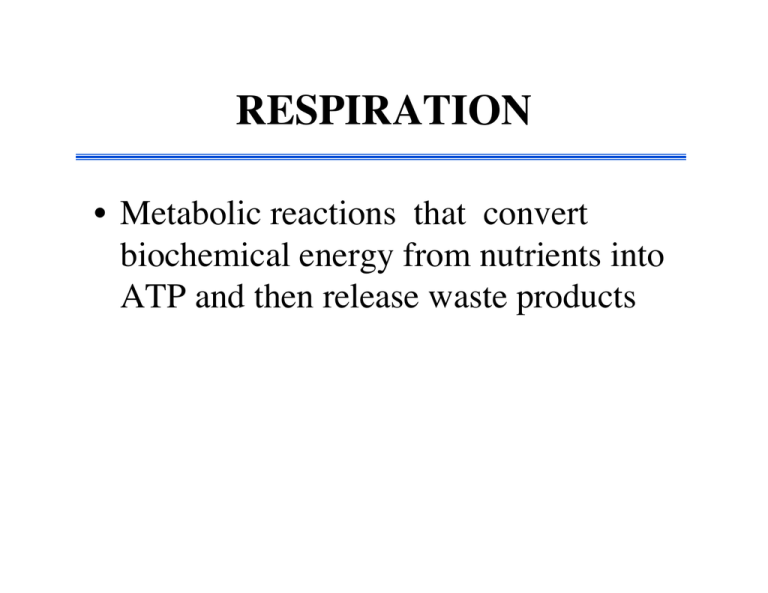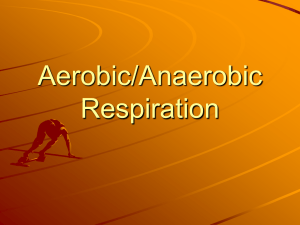RESPIRATION
advertisement

RESPIRATION • Metabolic reactions that convert biochemical energy from nutrients into ATP and then release waste products ENERGY FLOW • The basic picture TWO CATEGORIES • Producer and Consumer ENERGY FROM CARBO’S • Energy can be obtained via oxidation i.e. removal of electrons ANOTHER DEFINTION • Reduction is the gain of electrons REDOX REACTION • Def’n - Loss of electron(s) from donor and gain of electron(s) by receiver OXIDIZING GLUCOSE • Glucose + oxygen ➞ CO2 + H2O + energy OXIDIZING GLUCOSE • Glucose + oxygen ➞ CO2 + H2O + energy A FACT • In humans, the efficiency of transforming ADP’s into ATP’s is about 40% • In conventional automobile the tank to wheel efficiency is about 22% ANOTHER FACT • Glucose oxidation is facilitated by an enzyme - dehydrogenase • The dehydrogenase enzyme uses a cofactor NAD+ to pick up electrons (goes to NADH) C3H4O3 YET ANOTHER FACT • The process of getting energy from NADH is facilitated by electron carrier molecules in a chain ELECTRON TRANSPORT CHAIN ANOTHER FACT • Aerobic respiration is efficient and dangerous FREE RADICALS • Atoms or molecules that have orbitals containing single, unpaired electrons • Superoxide O2 - WHAT IS AGING? • Damage that accumulates over time OXYGEN IS DANGEROUS STUFF! • Even the former president of the United States should eat his broccoli From The World Book (TM) Multimedia Encyclopedia (c) 1999 World Book, Inc., 525 W. DEALING WITH FREE RADICALS • Catalase, an extremely efficient antioxidant enzyme DEALING WITH FREE RADICALS • Superoxide dismutase • Vitamin E • Vitamin C Vitamin E RESPIRATION WITH O2 IS COMMON, NOT UNIVERSAL • Aerobic • Anaerobic STAGE 1 • GLYCOLYSIS TWO POINTS ABOUT RESPIRATION • Historical • Mitochondria TWO FACTS • Some ancient bacteria by virtue of tolerance to oxygen were preadapted to exploiting it • All eukaryotes harbor mitochondria and all respiration takes place in those mitochondria A FACT • Mitochondria bearing striking similarities to bacteria WHY LIVE INSIDE A HOST? • Protection • Increased efficiency • Access to limiting materials ANOTHER FACT • Mitochondria are maternally inherited. STAGE 2 - Kreb’s Citric Acid Cycle STAGE 3 - Electron Transport ENERGY HARVESTED A DIFFERENT STAGE 2 • Fermentation SOME PRODUCTS FROM FERMENTATION PYRUVIC ACID NADH/NAD+ Acetone+CO2 ETHOH +CO2 Acetic Acid +CO2 Lactic acid Butanol POINTS TO KEEP IN MIND • Fermentation is NOT an energyreleasing process • Th end points of fermentation retain high amounts of energy WHEN FERMENATION COMES IN HANDY • Low needs, anaerobic environment • Difficult situations AEROBIC VS ANAEROBIC EXERCISE DO NASAL STRIPS HELP ATHLETES? • NO!






